Only about 10% of blind people around the world can read Braille. One primary reason is the high cost of Braille displays. The cost is a result of their complexity and reliability – required to ensure that they are able to handle wear and tear.
[Vijay] has been working since 3 years on a Refreshable Braille Display but has only recently been able to make some substantial progress after teaming up with [Paul D’souza]. During his initial experiments, he used dot matrix printer heads, but the current version uses tiny vibration motors as used in mobile phones. He’s converting rotary motion of the tiny motors in to linear movement for pushing the Braille “cell” pins up and down. The eccentric weight on the vibration motor is replaced with a shaped cam. Continuous rotation of the cam is limited by a stopper, which is part of the 3D printed housing that holds the motors. Another 3D printed part has three cam followers, levers, springs and Braille pins rolled in one piece, to create half a Braille cell. Depending on the cam position, the pins are either pushed up or down. One Braille cell module consists of two cam follower pieces, a housing for six vibration motors, and a cover plate. Multiple modules are chained together to form the display.
The next step would be to work on the electronics – in particular ensuring that he is able to control the motor movement in both directions in a controlled manner. Chime in with your comments if you have any ideas. The 3D design files are available from his Dropbox folder.
The other complementary project he is working on is the Braille Keyboard – a tactile input device that can be used along with smart phones, tablets, and computers. He’s based the design around an Arduino micro with BLE for connection to a smartphone and a USB port for computer use. The device will be battery powered, and housed in a 3D printed case. It will have a set of 12 main buttons and 4 direction buttons contoured and positioned to help make typing easier, while a vibration motor will provide haptic feedback. A speech option is also planned to pronounce each character as it is typed. This one is still pretty much on the drawing board, but we do hope he takes it forward over the next few months to build and test some prototypes.
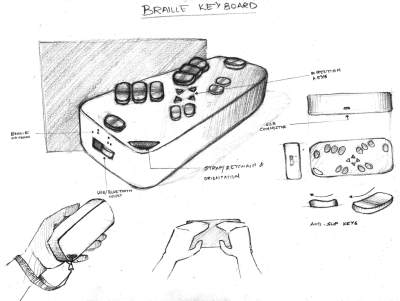

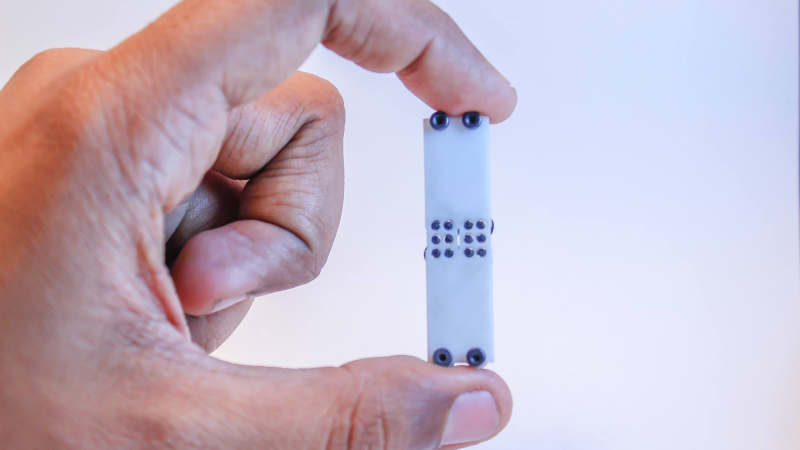
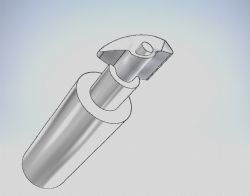
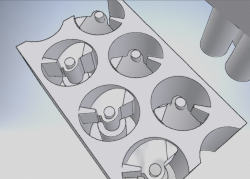

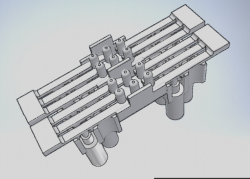



















Wouldn’t it be more compact to use a coil and stator to actuate the pins? Or some piezo electric system?
This is damn cool though and if it goes somewhere will probably be a great help to those who need it.
I see a major flaw in this design: 6 dots. Braille display usually have 8 dots in 2×4 configuration, bottom two are used as either cursor markers or for special characters. For blind person it is important to not only be able to read the text, but also know, where one’s cursor is located. Commercial products also have buttons above or below each letter just for moving cursor to selected place in text.
I’d love to see a display with vertical cell construction to reduce its footprint, so more than one line could be added mimicking page of Braille text.
I would call that a minor flaw: simply add two more dots!
I am more curious if the small motors can actually work in this application without additional gear reduction – both for engaging the pins and for holding them there while someone runs their finger over them.
It appears quite optimistic in the current configuration.
holding them there should not be an issue – if you look at the cam profile, it has a flat spot at the end of its travel, essentially locking the pin in place, a rather nifty trick i think. The torque applied may be an issue, particularly after prolonged use (fluff/grime etc).
With the motors un-energized, wouldn’t it just travel back down the incline plane?
It’s only resting on the incline during transition; when it’s all the way up it’s a flat against a flat, no inclination.
I tried it with a 6mm vibration motor
https://hackaday.io/project/10849-refreshable-braille-display/log/37153-pin-actuation-looks-promising
Cool! Looks compelling. I can see some potential issues with these motors dying randomly on you, but it is obviously r&d at this point.
Congratulations on sticking with your project. I am sure I am not the only one watching your progress!
Those motors don’t tend to ‘die randomly’. I’ve never had the vibration fail on my old cell phones even with going off for every call and alarm. I do see your point- it’s not being used as designed.
I think this project is an excellent idea! We could Bluetooth link it to a phone and a blind person would have another HID option. I once tried the ‘vision assistance’ mode on my phone and it was absolutely terrible.
notarealemail:
Do you ever grind your pager motors to a halt, while still energized, over and over and over, as a part of regular operation?
I am not sure you understand how electric motors work.
Yeah you’re right. I missed that part while reading the first time. They can get hot quick.
My bad.
No deaths with these motors even after a year of stop start operation. https://www.youtube.com/watch?v=zWvCRdcyyLc
“I see”
hehe…
Designed something similar a few years back, as when I repaired one of those high-end displays there was 70v unshielded piezoelectric drivers floating about 4mm away from the user’s fingers. Needless to say, I was shocked in more than one way… Also found out the hard way, that ascii art pisses blind users off one line at a time.
:)
Note, there’s already FOSS software to handle most of what you’d like to do, and a $5 Raspberry Pi zero could run a low end TTS. Try “apt-get install brltty-flite” for starters, but note brltty is known to interfere with some modules.
You will find many blind users are comfortable in a CLI shell environment, and often count menu position clicks on Android GUIs as it already has TTS built-in.
There is certainly room for a lower-cost simple displays, but it would be awesome if someone could modernize device concepts rather than an 80’s style CLI segment.
This is awesome! thanks!
I was once involved in a research project that used piezoelectronic vibrators to simulate surfaces. Pages 32 and following of this document have some details about the hardware: http://haptex.miralab.unige.ch/public/deliverables/HAPTEX-D4.3.pdf
I’ve never heard of a braille keyboard or even considered that there was a need for one. I assumed blind people just used regular keyboards a learned the placement of everything, or at the least had special key buttons with braille on them.
If the modern qwerty keyboard evolved from a typewriter, why shouldn’t it be the same for braille?
https://www.google.co.in/search?q=perkins+brailler&espv=2&biw=1280&bih=658&tbm=isch&imgil=q-ZFolfffcvFUM%253A%253BSpRrS5pp8QFLtM%253Bhttps%25253A%25252F%25252Fshop.aph.org%25252Fwebapp%25252Fwcs%25252Fstores%25252Fservlet%25252FProduct_communication%2525252520modes%2525252520braille%2525252520writing%2525252520writers%2525252520devices%2525252520daily%2525252520living%2525252520braille%2525252520reading%2525252520braillewriters%2525252520family%2525252520electric%2525252520light%2525252520touch%2525252520lite%2525252520perkens%2525252520perkans_1-00815-00P_10001_11051&source=iu&pf=m&fir=q-ZFolfffcvFUM%253A%252CSpRrS5pp8QFLtM%252C_&usg=__TEeVbAiJ2m9Pjarcb5UHo5PDkH4%3D&ved=0ahUKEwjime2UjLTMAhUObY4KHdy5BqAQyjcIRA&ei=pXQjV6KzAo7auQTc85qACg#imgrc=q-ZFolfffcvFUM%3A
Some commercial units, of course, have his functionality built in.
Perhaps I will dig up my old work I did on this topic and post it somewhere for you.
There are 32 variations of the 6 dot matrix, so the whole thing could be implemented as a belt with holes and ball bearings for the dots, which then fall in the holes in the belt. A single motor can wind a shaft, and solenoids for each character press the belt onto the shaft until the right character appears.
If you use an 2×4 matrix, two belts with 16 different hole patterns can be placed under each half of the character in the same scheme.
That reduces the number of actuators per character to just one or two, and it becomes a simple matter of measuring belt position and stopping at the correct place.
Sorry, 64 variations for 2×3
Anyways, a disc-cam system could also be used for the same effect.
I have somewhere a Braille-learning aid in form of three cube formed of three square disks, each of them having on each face left dot, right dot, two dots or no dots at all, disks are mounted on common shaft. Add fourth disk, make it much smaller and add four solenoids for rotating them and you will have rather slow but easy to make display. Mechanism goes down, disks are rotated with pulses, mechanism goes up locking them in position. It could be even used as smart sign, because it will require power only when it changes…
Worked on one of these devices using rotating octagonal disks called the Natesan Braille Display. Very very slow and very mechanically intensive! Vijay, great progress!
Thats a good idea.
I’m going to be stuck on Wikipedia for awhile because of piezos, braille keyboards, linear actuator designs, and mechanical displays.
Hackaday has proven itself a similar time-sink as Tvtropes.
I have been working on these for over 6 years now…look at my YOUTUBE channel
https://www.youtube.com/watch?v=zWvCRdcyyLc
While I have been supportive and impressed with Vijays efforts in trying to produce a rapidly prototyped Refreshable Braille Display thus far, I was just informed by my patent attorneys that that I need to let it be known that before this Refreshable Braille Display project is taken forward further it must be made known that all of the features published thus far are covered under a patent application filed at The Patent Office, Chennai, by myself on 05Nov2014 …5559/CHE/2014 . The said patent application for a Refreshable Braille Display covers the use of micro-motor actuated pins, the pin cantilever design, the mechanical stop to limit rotor rotation, motors with rotors or cams, mounted vertically or horizontally used to lift pins directly or via an interposer, low force selector etc. I prototyped just one of the variants covered by the patent that I deemed to be the most feasible and cost effective. Amongst the people following this project on this open forum there might be some who believe that this design is open source, and that prior arts and patents do not exist. I was advised that this impression needs to be corrected immediately. The public must be informed and know that if anyone wants to exploit features of this design, they would need to get in touch with me or my patent attorneys (Origiin IP Solutions LLP), as rules require that even the Patent Office be kept informed of activities in regards to patents.
Good luck with the project! I’m happy to see it advance. :)
Thanks for the update.
That’s what I thought !! You have been slogging on this for like more than half a decade and your design is being shown here like you are some chump designer whereas you are the legit inventor with valid patents !!!!l Please stop going to these hackerspace or makerspace or whatever and displaying your works… there seems to be no control on copying by the unscrupulous.
so I guess that is what the orbit reader 20 is using then sounds interesting. Maybe the science channel will have a how its made show on it someday. everyone just google orbit reader 20. It should be out by October and I can’t wait to buy one!